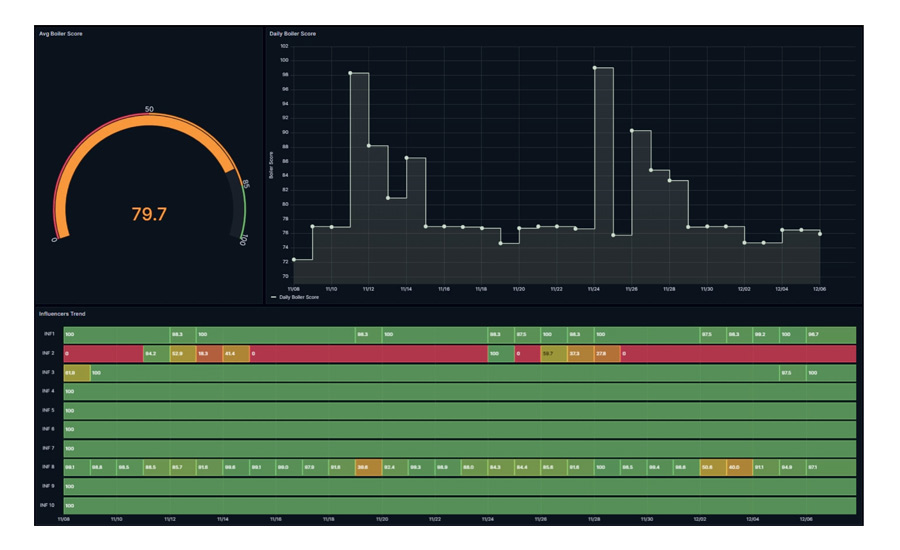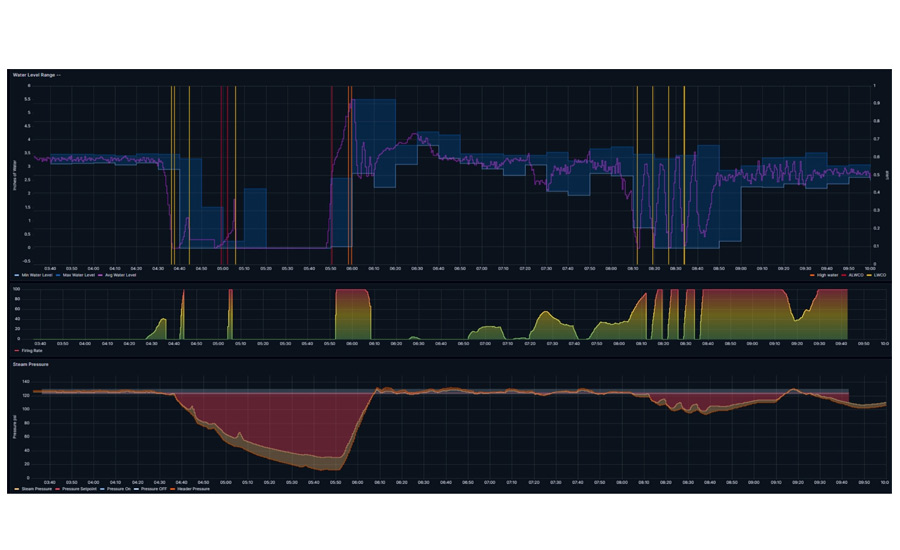Troubleshooting boiler issues is primarily reactive, driven by sensors, sounds, and alarms; but the Internet of Things (IoT) is changing that. The IoT enables immediate access to real-time, operational data. It works by collecting data, sharing it through the cloud, and integrating it with software to analyze and transmit via an app or website.
Boiler IoT enables facilities to optimize operations, predict potential issues before they escalate, and reduce downtime and maintenance costs. An operator can remotely monitor plant combustion, feedwater temperatures, stack temperatures, makeup water rate, and almost any other parameter imaginable. This facilitates quick decision-making in response to changes delivered via alerts or notifications.
Identify Patterns and Anomalies
Gone are the days of a technician sitting in front of a boiler for hours waiting for an event to repeat itself, hoping to be able to understand what happened. Now, an operator can simply review past performance and identify exactly when and what was occurring in the boiler room to cause the event. A user can analyze past operational patterns to predict future needs and understand seasonality or time-based variations in boiler operations.
Operators can set key performance indicators (KPIs) to do a deep dive into the data to understand boiler health and performance. They can also benchmark against previous performance metrics and prioritize areas of improvement based on the KPIs.
Boiler performance at-a-glance
Data is only useful when viewed in a report or format that establishes baselines, benchmarks, and goals for optimization and sustainability. Additionally, the best decisions are made when trends are highlighted, and reports are customized to match a facility’s needs.
Predicting potential issues
One of the greatest benefits of boiler IoT is proactive diagnostics. This is achieved by using advanced algorithms to predict potential issues before they escalate, reducing both downtime and maintenance costs.

One example of proactive diagnostics is a boiler health score. Based on design and operational KPIs, a boiler health score provides operators and management with a quick check of a system’s risk areas and improvement opportunities. A trusted advisor can then make recommendations for adjustments or maintenance based on the diagnostics.
IoT Reveals Reasons for Shutdowns
In one medical facility, three boilers were not sustaining their loads and supporting hospital operations due to numerous low-water-cutoff (LWCO) shutdowns. The facility wanted to address the issue and tapped its local Cleaver-Brooks representative for expertise.
Prometha® IoT Connected Solutions was installed to observe the boiler’s operation over a 30-day period. Within the first week, the boiler service company determined the root cause of the shutdowns.
The boilers were failing at various levels based on their location in the feed system. Boiler 1 had the most failures, and Boiler 3 had the fewest.
Prometha revealed the trajectory of a dot cluster crossing 1 inch at ~60% firing rate. When the trajectory of the dot cluster is less than a water level of 1 inch, a boiler is likely to experience LWCO at high fire.
Figure 3 shows variability in the water level ranging 1.2 inches. Variability increases as the boiler firing rate rises. Ideally, the range should only be 0.2 inch of water.
Armed with boiler data, operational trend reports, and extensive boiler knowledge and experience, the rep discovered the chemical injection system was installed using a common injection point located near the front of Boiler 1. The conductivity of the boiler water ranged from 6,000-plus microohms per centimeter on Boiler 1 to 2,500-plus microohms per centimeter on Boiler 3, causing an unstable water level that created a bounce effect to the water level when the boiler load transitioned. In addition, the boiler operating range was set with a 3-5 psi for boiler-on and boiler-off settings, so the boilers were in a constant state of transition from low-to-high fire, leading to excessive LWCO events.

The rep recommended that the medical center correct the chemical injection location, monitor water chemistry limits, groom the boiler controls, and spread the on/off points to enable the boilers to operate with a normal sine wave pattern.
After the facility implemented these actions and addressed its water chemistry issues, all three boilers are now fault-free.
The boiler system is now safer with increased reliability, efficiency, and sustainability. Plus, the medical center is projected to save approximately $10,000 annually in gas and electrical costs.
Training opportunity
In addition to reporting and proactive diagnostics, working with real facility data is invaluable to bring a new operator up to speed on how the system operates. Graphics and trending data are useful to teach the cause and effect of changing system parameters. Showing how plant data looks when it is operating normally and reviewing trends that identify abnormal operations can help prevent issues and downtime.
Boiler IoT is much more than just charts and graphs. For operators and management, data without intelligence is just numbers. Together with the expertise provided by a boiler expert, an IoT boiler solution can drive better decision-making by:
- Providing trend data regarding main operational KPIs to ensure the boiler system maintains optimum efficiency, leading to cost savings and energy conservation.
- Generating detailed and customized performance data for informed decision-making and preventive maintenance.
- Providing actionable insights and alerts that help identify issues and opportunities for improvement, leading to reduced downtime and maintenance costs.
- Assisting in facility oversight when an operator or maintenance technician is away from the boiler room, elsewhere in the facility, or across the country.
- Offering a support network and training opportunities to better understand and manage the boiler system, improving overall performance and system lifespan.
- Providing one-way secure data flow with top-tier encryption and regular cybersecurity evaluations to preserve data sanctity.
By John Pemerton, corporate director, Prometha services, Cleaver-Brooks




